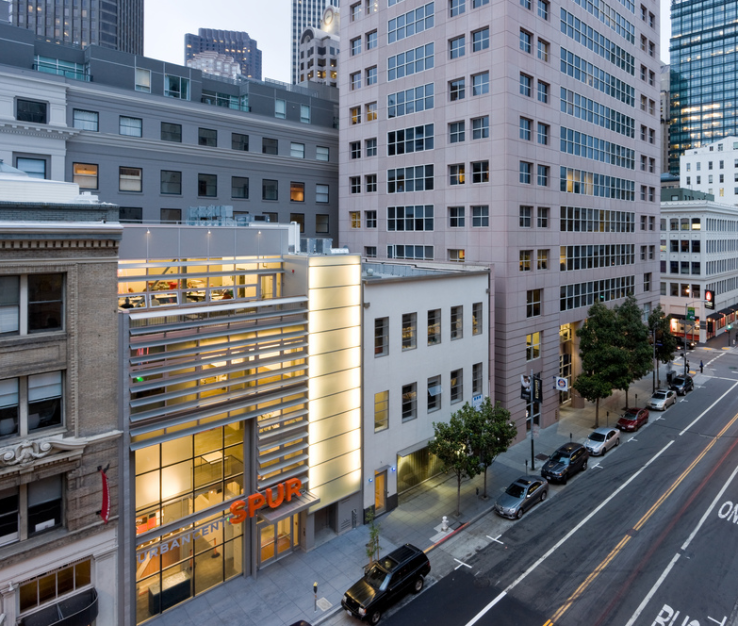Anne W. Halsted Hall
 In 2023, SPUR’s second-floor assembly hall was named Anne W. Halsted Hall in honor of long-time SPUR board member and former board chair Anne Halsted. Anne was involved with SPUR for more than 50 years, leading the organization through an important revitalization in the 1990s. Later, she became a strong advocate of taking a regional approach to solving the Bay Area’s most intractable issues while remaining firmly committed to elevating community voice. Anne’s passing in 2021 left a lasting legacy both at SPUR and throughout the Bay Area.
In 2023, SPUR’s second-floor assembly hall was named Anne W. Halsted Hall in honor of long-time SPUR board member and former board chair Anne Halsted. Anne was involved with SPUR for more than 50 years, leading the organization through an important revitalization in the 1990s. Later, she became a strong advocate of taking a regional approach to solving the Bay Area’s most intractable issues while remaining firmly committed to elevating community voice. Anne’s passing in 2021 left a lasting legacy both at SPUR and throughout the Bay Area.
Anne Watson Halsted was born in West Virginia in 1942. She spent her early years in Cleveland and Milwaukee before attending Duke University, where she graduated with a bachelor’s degree in political science in 1964. Attending Duke before it was integrated, Anne gained special appreciation for the struggles of race relations while working a student job in the kitchen alongside Black workers from Durham. Meanwhile, she gained an interest in community organizations and citizen participation through her courses in comparative politics.
After college, Anne moved to San Francisco, where she found an entry-level job as a receptionist at Parsons, Brinckerhoff, Quade and Douglas, the engineering firm that was designing BART. In 1969, she began work in the personnel department of equipment financing firm United States Leasing, where she hired staff and managed benefits, payroll, and employee relations. During her 21 years there, she grew to become a vice president and part of the management team. It was a time of considerable change in employment practices, when institutions were opening their doors to beneficiaries of the Civil Rights Act. The act created opportunities for aware executives like Anne to advance progressive policies in employment and increase racial and gender diversity in their workplaces.
A resident of North Beach, Anne first got involved in community issues when she organized neighbors to change traffic laws on an alley where high-speed vehicles were creating a safety hazard. She went on to serve as president of the Telegraph Hill Dwellers, helped to pass a property tax to fund neighborhood parks, and co-chaired the first San Francisco Open Space Advisory Committee to recommend ways to spend the tax revenue. Later, she was appointed by Mayor Dianne Feinstein to the San Francisco Redevelopment Agency Commission and subsequently to the San Francisco Port Authority, where she was the first female commissioner, serving from 1984 to 1996.
Anne retired from United States Leasing in 1990 to focus her talents on civic engagement. She served on the Treasure Island Development Authority, and in 2001 Governor Gray Davis appointed her vice chair of the San Francisco Bay Conservation and Development Commission. She also served as BCDC’s representative to the Metropolitan Transportation Commission from 2005 until 2020.
During these periods of public service, Anne also devoted countless hours to nonprofit boards and community groups. Nationally, she served on boards of many organizations, including the Women’s Campaign Fund and Business Executives for National Security. Locally, she sat on the boards of the Greenbelt Alliance, Friends of the Urban Forest, City Club, the Institute on Aging, the San Francisco Maritime National Park Association, the International Institute, Chinatown Community Development Corporation, the Neighborhood Parks Council, North Beach Citizens, the Legal Aid Society, and the Immigration Institute of the Bay Area.
Among the organizations most important to Anne was SPUR, which she belonged to for over 50 years, serving twice as board president. Anne played leadership roles in SPUR projects such as San Francisco City Charter reform, the Waterfront Land Use Plan, Golden Gate Park planning, the redesign and rebuilding of Union Square, and the conception of the Blue Greenway. In fact, there is not a major SPUR project that Anne was not involved in, including the conception of the Presidio Trust, military base reuse planning for Treasure Island, the design of the Embarcadero and Ferry Plaza, planning for Chinatown, and creation of the Downtown Plan.
Anne also worked to build the institutional infrastructure for SPUR to grow and thrive. This work included getting the organization on solid financial footing, growing the staff and board, and developing the organizational culture. Anne’s human relations background and caring personality were ideally suited to transforming a small organization into the powerhouse that SPUR is today. She worked tirelessly on the campaign to build the SPUR Urban Center and, in her most recent board term, served as a thoughtful voice in SPUR’s effort to center equity in its policy work.


 In 2023, SPUR’s second-floor assembly hall was named Anne W. Halsted Hall in honor of long-time SPUR board member and former board chair
In 2023, SPUR’s second-floor assembly hall was named Anne W. Halsted Hall in honor of long-time SPUR board member and former board chair